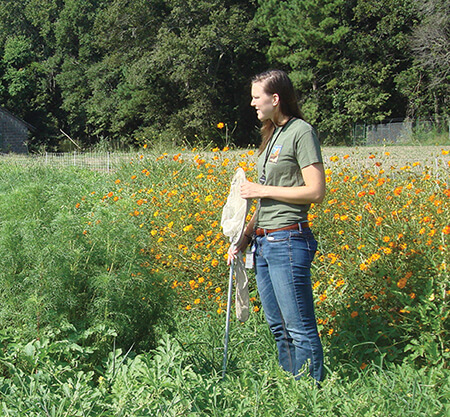Denise Attaway, College of Agriculture, Forestry and Life Sciences; Public Service and Agriculture
CHARLESTON – A Clemson University graduate student has found adding a little color to watermelon fields can attract pollinators which can help improve quality and increase yields of one of South Carolina’s most important vegetable crops.

Miriam “Mimi” Jenkins of Tampa, Florida, has found growing strips of wildflowers near watermelon fields can help attract pollinators, such as native insects and honey bees. Watermelons need pollination to produce melons. A diversity of pollinators is desired to ensure plant success. Jenkins included her findings in the final chapter of her dissertation, Enhancing native pollinators of watermelon agroecosystems in South Carolina, which she wrote as an Extension publication. She graduated from Clemson with a doctorate in wildlife and fisheries biology in May.
“Pollinators are declining at alarming rates due to a combination of habitat loss and a lack of food resources, increased pests, parasites and pesticide use,” Jenkins said. “More than 75 percent of the world’s leading food crops rely on animal pollination for maximum quality and yield. In addition, many crops produce more fruit or better-quality fruit when a more diverse community of pollinators contribute to pollinating the crop. Wild pollinators also pollinate about two-thirds of wild flowering plants in natural ecosystems. These plants provide food for other wildlife from birds to bears.
“Protecting these keystone species is critical for the future of the food supply and functioning ecosystems alike.”
Honey bee hives were placed near all fields so that honey bees could pollinate the watermelon crops. During her study, Jenkins found most of the watermelon plant pollinators were native bees, despite the nearby hives. Honey bees are not native to the United States. Most honey bees are native to south and southeast Asia. The western, or European, honey bee is native to Europe, the Middle East and Africa.

Native wild bees are more efficient pollinators of watermelons, as well as improve seed set, quality, shelf-life and commercial value of many crops. But native bees need flowers and nesting sites. Jenkins’ study found native bees or more precisely, tiny sweat bees, were pollinators that most often visited fields that included wildflower strips or hedgerows – wild shrubs and trees.
“Wildflowers and hedgerows can provide food and nesting resources for bees and other pollinators,” Jenkins said. “They also can provide food and nesting resources for predatory and parasitic insects, which can help provide species diversity and abundance of beneficial insects.”
To attract different pollinators, Jenkins planted the wildflowers in strips containing four native plant species – Zinnia elegans, also known as common zinnias; Gaillardia pulchella or Indian blanket; Coreopsis tinctoria or Golden Tickseed and Cosmos sulphureus, commonly called “cosmos.”
“These plants were chosen for their drought-tolerance, fast germination rates, hardiness, difference in flowering period, length of flowering period and attractiveness to a variety of pollinating insects,” Jenkins said. “A resilient and stable pollinator community includes a diverse suite of pollinators with a range of nesting habits, foraging behaviors and activity periods.”
Pollinator communities have different behaviors and traits that complement each other and can buffer against year-to-year fluctuations or environmental changes that affect pollinator species differently. In fields with wildflowers, researchers observed or collected a wide range of pollinators and insects that do not pollinate watermelon but pollinated other nearby flowers.
“South Carolina growers should consider implementing on-farm efforts, such as planting wildflower strips, to conserve diverse pollinator communities for the future of watermelon crops and other pollinator-dependent crops,” Jenkins said. “Adding natural habitat areas on farms has been found to increase crop yields because these areas attract more pollinators, including beneficial insects.”
To support pollinator diversity and support native pollinators, Jenkins advises growers to:
- increase floral resources by planting wildflower strips of native flower species in or along the edges of fields,
- increase nesting sites by maintaining semi-natural areas on farms and reducing soil-level disturbances and
- minimize pesticide use.
Jenkins’ study was conducted on several farms throughout South Carolina. Rosebank Farms on Johns Island was one. Owner and Clemson alumnus Sidi Limehouse uses bees to pollinate his watermelon crop.
“Bees are very intelligent,” said Limehouse, who is the 2019 Swisher Sweets/Sunbelt Expo South Carolina Farmer of the Year. “Once they become acclimated to an area, they get to work pollinating and crops are better for it. We protect native pollinators, thereby reducing our overall insecticide use and increasing our yields.”
Other locations used for the study include watermelon fields in central and coastal South Carolina, including Freeman Farm in Greer, Dixie Farms in Chesterfield, the United States Department of Agriculture (USDA) Vegetable Laboratory in Charleston, as well as other USDA fields, and in fields at the Clemson Coastal Research and Education Center in Charleston.
The study was supported in part by the Margaret H. Lloyd Endowment at Clemson University. Lloyd Endowment chair Robert Baldwin said it is important to keep areas of natural habitat near farm fields, because these areas are where many pollinators live.
“Biodiversity, including bees, provides free services for our economy but we need to understand where these bees go outside of their fields so those areas can be conserved,” Baldwin said.
For more information, read Chapter 4 of Jenkins’ dissertation at https://tigerprints.clemson.edu/all_dissertations/2382.
Watermelon belongs to the cucurbit, or gourd, family and is considered a vegetable. It is produced in all 46 South Carolina counties. About 80 percent of watermelons produced in South Carolina are seedless. According to the USDA, 4,500 acres of watermelons were planted in South Carolina in 2018. Nathan Smith, Clemson Extension economist, said the total economic contribution of watermelon production on the South Carolina economy is estimated to range between $33 million to $35 million.
Watermelons are sold at supermarkets, farmers markets, roadside markets and other places where produce is sold. The South Carolina Department of Agriculture has listings for community-based farmers markets and state farmers markets available on its website http://www.agriculture.sc.gov/?s=farmers%20markets.